The battered dustpan hangs on a peg of its own. It's within easy reach for a tall man. A never-opened ball of string from Ace Hardware sits on a shelf with a tape measure, Minwax Tung Oil Finish, and other objects grouped by category. Jars of paint are lined up near cans of brushes and colored pencils.
This is the studio of widely-known Miami artist Robert Huff. It's the hands-on toolkit of a lifetime, now captured in photographs included in the new book, “Robert Huff: Cross Section.” The images show a space that seems waiting to host more creativity. That ball of string is ready to be unwrapped, those brushes and pencils poised to produce streams of color.
And yet, a strange quiet pervades these photographs. Architectural photographer Steven Brooke took them a few months after Huff's death at age 69 in 2014.
.
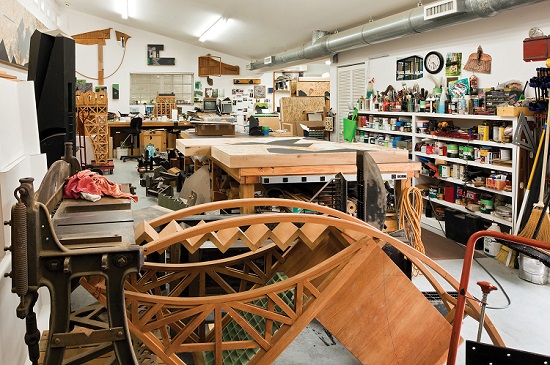
Robert Huff Studio 2014. Photo by Steven Brooke; page 207 of "Robert Huff: Cross Section." Courtesy Letter 16 Press.
.
Even though Huff had received a diagnosis of cancer several years before, he had continued to produce affecting work. Untitled (New River Trail) is the last image in the book, dated the year the artist died. Dramatically rendered on four panels with acrylic, pencil and foil, jagged black forms recall the mountains in southwestern Virginia, a place where he also kept a studio.
With singular clarity, eight photographs of the silent studio in Miami punctuate this gorgeously illustrated book, featuring more than 200 exquisite color reproductions of Huff's art. The book is a revealing look at his 47-year career as a multi-tasking, multi-talented sculptor and painter whose love of drawing informed everything he made.
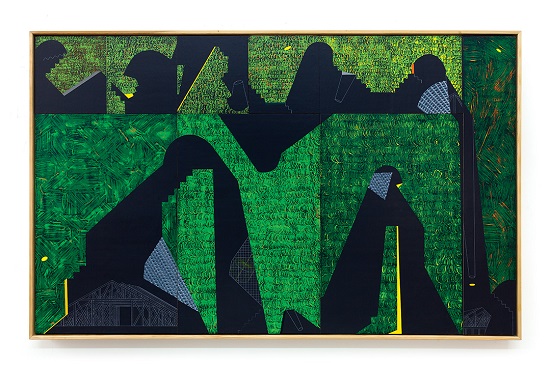
“HR Rapier Ridge” by Robert Huff, 2008. Acrylic, pencil on panel, 46 x 74 x 4 inches. Courtesy Letter 16 Press.
.
The publisher is Letter 16 Press, a small press in Miami best known for books on Miami photographers who traversed creative terrains mixing photojournalism with art while working in the pre-digital age. As Letter 16 Press co-founder Brett Sokol explained in an email, "‘Robert Huff: Cross Section’ was a special project in light of Huff's importance as one of Miami's most important visual artists whose career spanned this city's pre-and post-Art Basel periods."
An influential artist and educator, Huff left an indelible mark on the South Florida art community. From 1979 to his retirement in 2005, he chaired the art department of Miami Dade College, Kendall Campus. Widely traveled and always curious about working with materials new to him, he was known for sharing what he learned with students and fellow artists.
Dozens of Florida museums and galleries have shown his work, as well as those in Chicago, United Arab Emirates, and Kassel, Germany. Huff produced numerous public art commissions. He took part in artist residencies in the former Soviet Union. In 2015, Miami Dade College Museum of Art & Design presented "Robert Huff: 47 Years," a gathering of 34 works from the early 1970s to 2014.
.
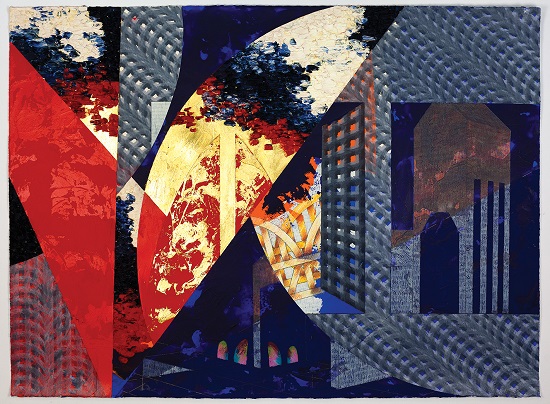
“East West #8” by Robert Huff,, ca. 1992. Acrylic, pencil, oil on paper, 22 x 30 inches. Courtesy Letter 16 Press.
.
“Cross Section” provides a look at Huff's career that is at once broader and more intimate. It is distinguished by commentary from those in his art community who knew him for years, including his first Miami dealer Robert Sindelir, art and design writer Beth Dunlop, the late art historian and critic Helen L. Kohen, and his wife, retired Miami art librarian Barbara Young.
In her introductory essay, "A Well-Drawn Life," Dunlop explains, "His was a family of builders and outdoorsmen, fueling his passion for both the manmade and the natural world, for land and sea--most particularly fishing and boating." She recounts how Huff's pervasive sense of line, articulated in pencil and paint, not to mention wood and metal, shaped so much of his desire to evoke the colors and textures of landscapes surrounding him. He "was driven by a profound curiosity and immense pleasure in the world he observed," she writes.
.
.
Huff was a visually eloquent witness to South Florida's rapid if not rapacious urban development, beneath magnificent summer and winter cloudscapes. The book illustrates his growing fascination with gridded and architectural forms evoking shadowy canyons of skyscrapers, scaffolding and bridges, particularly as he hit his stride as an artist in the 1980s with such works as Mirage I.
.
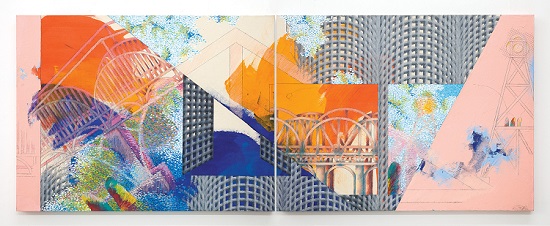
“Mirage I" by Robert Huff, 1987. Acrylic, pencil, oil on canvas, diptych, 32 x 86 inches. Courtesy Letter 16 Press.
.
Yes, his art was abstract, but finely woven with poetic allusions to the real world he perceived with acute sensitivity. There would be wry references to Turkey Point nuclear power plant on Biscayne Bay and to the vital and delicate green fringe of mangroves edging Miami's vulnerable coast line. Later works produced after his travels to Russia, such as After Leningrad #8, reflect how his awareness of the brilliant red and gold of Russian icons shaped his ambitious and porous imagination.
.

“After Leningrad #8” by Robert Huff, 1992. Acrylic, pencil, oil, gold leaf on paper, diptych, 22 x 60 inches. Courtesy Letter 16 Press.
.
After Huff and Young retired, they spent increasing amounts of time at their 9-acre property in southwestern Virginia. The leafy Appalachian mountains provided Huff with another dynamic landscape to portray in his art, but he and his wife were disturbed by the region's development and destructive mining. South Florida's opalescent light is absent from these later and darker works in the book.
At the request of the artist's widow, Miami-based photographer Steven Brooke took studio photographs for this book. Young remembers the day she called Brooke, thinking at first he might recommend a fellow photographer for the task. Brooke arrived that afternoon with his camera.
Brooke said he was "honored" to be asked. "I had known Robert for years," he explained in a February 2017 phone interview.
"I see the studio as a kind of portrait of Bob," Young said during a February 18, 2017, interview at the Miami home the two shared. "Bob had a wonderful sense of order. There was an awful lot going on in his studio, but it was organized beautifully. He had three workspaces, a table for drawing, and another table for the wood sculpture."
"I can't even tell you the names of all the tools he had. Lots of different kinds of brushes. He had containers and containers of different kinds of colored pencils. He always drew," she remembered. "Colored pencils were a constant throughout his career."
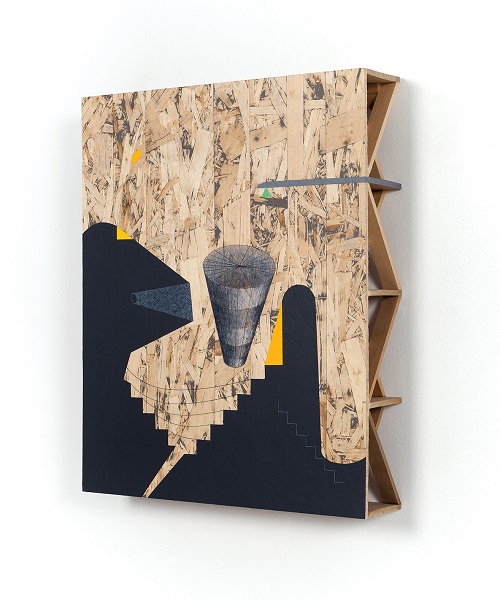
“H R 6-12” by Robert Huff, 2012. Acrylic, pencil, OSB, 20 x 16 x 4 inches. Courtesy Letter 16 Press.
.
This book illustrates the scope of Huff's career and also makes more visible than ever the heartfelt civic generosity deeply connected to his creativity. This creative spirit helped to define a man who adored South Florida's water and light. Both artist and educator, he was a respected, active player in the region's cultural scene as it expanded from the early 1970s to the present. In fact, his life and art, documented here, offer a telling portrait of the South Florida art community over nearly five decades.
The book demands to be seen as a passionate corrective to today’s dangerous, divisive and contentious times. Among its many beautiful pages, the book sounds a clarion call—especially now when, after years of assault and overdevelopment, the natural world that Huff loved is being despoiled at an alarming rate. It's well-established that rising seas are already bringing epic flooding to Miami, with more to come. Still other disasters are looming.
.
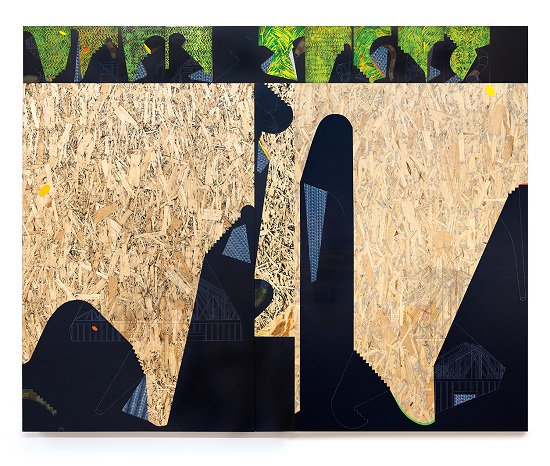
“HR Cold Ridge” by Robert Huff, ca. 2009. Acrylic, pencil on OSB, 70 x 87 x 4 inches. Courtesy Letter 16 Press.
.
____________________
BASIC FACTS: “Robert Huff: Cross Section” (Letter Press 16, Miami; 216 pp, hardcover; edition of 500). Introductory essay "A Well-Drawn Life" by Beth Dunlop. 208 color photographs by Steven Brooke, Francesco Casale, Jack Gardner, Robin Hill, Robert Huff, Raul Pedroso/Solo; 2 black and white photographs of the artist by Richard Lee Williams. www.letter16press.com.
_____________________
Copyright 2019 Hamptons Art Hub LLC. All rights reserved.

